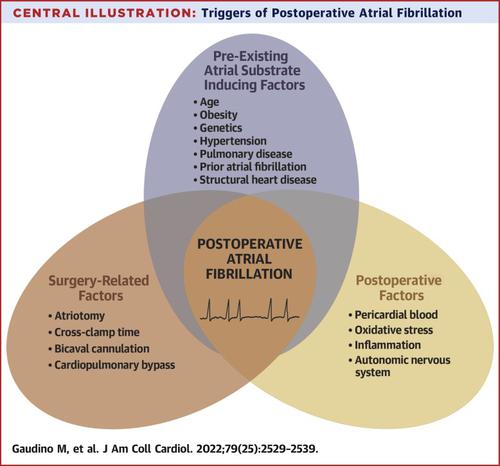Journal of the American College of Cardiology ( IF 24.0 ) Pub Date : 2022-06-20 , DOI: 10.1016/j.jacc.2022.04.029 Mario Gaudino 1 , Antonino Di Franco 1 , Lisa Q Rong 2 , Davide Cao 3 , Carlo A Pivato 4 , Giovanni J Soletti 1 , David Chadow 1 , Gianmarco Cancelli 1 , Roberto Perezgrovas Olaria 1 , Marc Gillinov 5 , J Michael DiMaio 6 , Leonard N Girardi 1

|
Postoperative atrial fibrillation (POAF) is the most common complication after cardiac surgery. Patients who develop POAF are more likely to experience adverse outcomes, including increased rates of death, stroke, heart failure, and hospitalizations, and higher hospital costs. Understanding the mechanisms underlying POAF is important to improve patients’ outcome and optimize health systems’ efficiency. Beyond classic pathogenic hypotheses, emerging evidence suggests that postoperative pericardial effusion and localized pericardial inflammation may trigger POAF. This hypothesis is supported by data from nonhuman animal models and a growing body of evidence showing that reducing postoperative pericardial effusion might reduce POAF incidence. In this review, we summarize the classic pathophysiology theories of POAF following cardiac surgery and discuss new etiologic mechanisms with a specific focus on the role of pericardial effusion and inflammation.
中文翻译:

心脏手术后心包积液引起心房颤动
术后心房颤动(POAF)是心脏手术后最常见的并发症。发生 POAF 的患者更有可能出现不良后果,包括死亡率、中风、心力衰竭和住院率增加,以及住院费用增加。了解 POAF 的潜在机制对于改善患者的预后和优化卫生系统的效率非常重要。除了经典的致病假设之外,新出现的证据表明术后心包积液和局部心包炎症可能会触发 POAF。这一假设得到了来自非人类动物模型的数据的支持,越来越多的证据表明减少术后心包积液可能会降低 POAF 的发生率。在这篇综述中,我们总结了心脏手术后 POAF 的经典病理生理学理论,并讨论了新的病因机制,特别关注心包积液和炎症的作用。



























 京公网安备 11010802027423号
京公网安备 11010802027423号